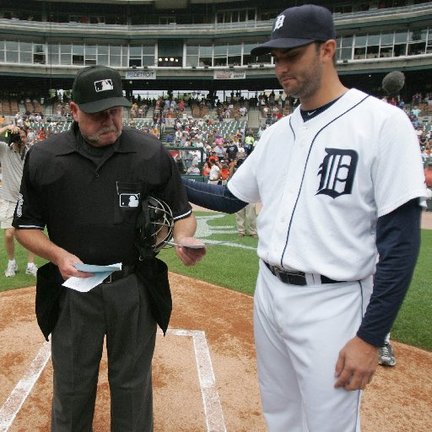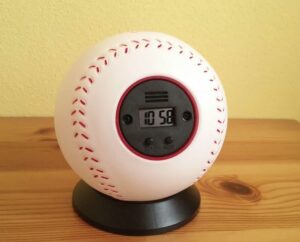Pitching a perfect game in baseball is the ultimate single game achievement. It’s the scenario we all imagine growing up. Two outs. Bottom of the ninth. One more out ‘til perfection. You can feel your heart racing. The crowd’s on their feet, and then–
Let’s rewind a little. We all know the perfect ending. You get the final out. 27 up, 27 down. You’re in the record books. But let’s imagine a more realistic outcome. You come out of the gates hot, pitching a gem. You can tell that you have it tonight, and then the outside world starts to react. By the fifth inning of no-hit ball, everyone knows that something special is in the works. Your teammates begin to stop talking to you in hopes not to jinx it. By the 6th, ESPN begins the live look-ins to check up on your progress. The Twittersphere is blowing up. Local teenagers call up their friends to tune into the game. By the 7th inning, it’s last call for beers, but those drunk college kids who planned to head out after they stopped serving remain in their seats. By the 8th, the uninterested businessman talking on his Bluetooth the whole game behind home plate starts to pay attention. Soon enough, it’s the 9th inning and anyone with any connection to the game knows what’s going on. The baseball gods have come down from Cooperstown to bless your arm. There’s sweat dripping down your face. Your teammates are equally as nervous wondering who is going to have to make the DeWayne Wise-esque game-saving catch. But guess what? Your fairytale can’t always have a happy ending.
But seriously, what did you expect? There are 162 games in a year and 30 teams. That means there are 162 x 30 = 4860 possible chances for a no-hitter or perfect game per season. That may sound like a lot of chances to witness the unthinkable, but history shows that only 299 no-hitters – 23 of which were perfect games – have been thrown since 1876. That is an average of 2.1 no-hitters a season and about one and a half perfect games per decade. Of course, there are stretches where no-hitters are more common due to new pitching techniques and changes in the regulations, but regardless it is no easy feat. More often than not, pitchers will throw 5-8 ⅔ no hit innings, build up suspense for viewers worldwide, and then lose it. That’s why a perfect game is called perfect. There can be no imperfections on defense – not even a single error or four ball sequence. To highlight the cruel, heart-breaking pain of almost achieving legend status in baseball, let’s look at some of the most famous could-a-beens.
***For this list we will look at games where no-hitters almost occurred, in addition to those in which perfect games almost occurred.
The Newbie: Sean Newcomb
There’s nothing too special about this near no-no from Newcomb. Two outs, two strikes in the ninth, Chris Taylor singles. However, it is important to include Newcomb’s bid to give perspective on how recent and ongoing of an occurrence this is.
Twice is Not Nice: Max Scherzer
Max Scherzer is perhaps the most unlucky person on this list. Not only did he lose one perfect game, he lost two perfect games. Not only did he lose two perfect games, he lost two perfect games in the same season. Not only did he lose two perfect games in the same season, he lost both to reasons pretty much out of his control. The first occurrence came on June 20, 2015, when he came one batter short of perfection. Remember that scene in Bad News Bears where Buttermaker tells one of his players to lean in so he can get hit by the pitch? Well, I’m guessing that’s what Jose Tabata was thinking about when he came up in the ninth. This guy is a major league baseball player and he has the nerve to lean into a pitch to break up the perfect game? C’mon man! It was 6-0. It’s not like that was going to help your team win.
Not even four months later, Scherzer pitched a no-hit, no-walk, 17 strikeout game. The only baserunner in this one came from a throwing error by Yunel Escobar in the sixth inning. Two games with no hits and no walks, yet no perfect game. This is very unfortunate. But Scherzer, you got two no-hitters in the same year, so you can’t complain too much.
12 Innings of Perfection: Harvey Haddix
A perfect game is defined as any game in which no batter from the opposing team reaches base. Under that definition, Haddix does not qualify. However, he did achieve “27 up, 27 down.” In fact, he went 33.3333… percent further than every pitcher to actually throw a perfect game by retiring the first 36 batters of the game. However, he gave up a run in the 13th, losing his perfect game, no-hitter, shutout, and victory.
One Too Many: Rich Hill
Imagine bringing a perfect game into the 9th inning, then losing it because of a fielding error. Then imagine finishing off that inning, with the no-no still intact, but then having to pitch another because your teammates failed to put up a single run. That’s exactly how Rich Hill felt on August 23, 2017. Regardless, Dave Roberts decided to leave Hill out to finish what he started. Did his manager’s faith in him pay off? Nope. Instead, the leadoff hitter, Josh Harrison, hit a walk off in the bottom of the tenth.
The 8 Inning No-No: Andy Hawkins
This one is just sad. Not on Andy’s part, but on the part of his teammates. Errors have blown games many a time. But Hawkins pitched eight innings of no-hit ball yet still lost 4-0. I could understand losing 1-0 because of an error and a walk or two, but four runs? Oh, and all four of these runs came in the same inning. Then two outs in the 8th were followed by an error, two walks and then two more consecutive errors, allowing four White Sox to cross the plate. Because the Yankees failed to score in the top of the ninth, the game was over and Hawkins had only pitched 8 innings. His no-hitter was stripped from him in 1991 when a new rule declared that a no-hitter must go at least 9 innings.
The 28-Out Perfect Game: Armando Galarraga
This is probably the most painful thing that could ever happen to a player in a baseball game. Sorry, Ray Chapman, but this dude’s got two Wikipedia pages: one for himself and one for this beautiful tragedy. Imagine you get to that point we talked about earlier: Two outs in the ninth. 26 up, 26 down. But then instead of simply running out of gas and giving up a clean hit, you get cheated out of it. To paint the picture, Jason Donald comes up and grounds a ball in the hole between the first and second basemen. Miguel Cabrera, who’s playing first cuts it off and makes a perfect throw to Galarraga who runs to cover first. The throw and Galarraga’s foot beat Donald by at least 12 inches and everyone celebrates. Within a second, Jim Joyce throws out his elbows indicating the runner’s safe. Imagine that. Everyone knows you retired the first 27 batters. Even Joyce knew it as soon as he made the call. But in a time before replay review, what should have been the last out to a perfect game looks like a line drive up the middle in the box score.
Image Credits: nj.com





